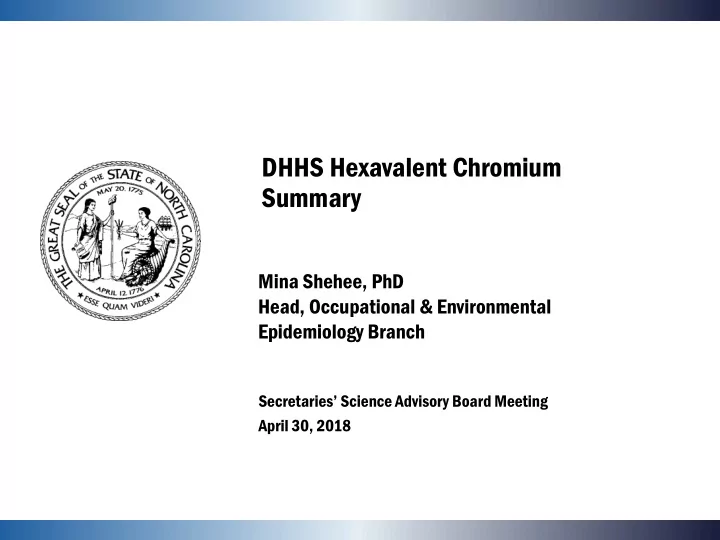

DHHS Hexavalent Chromium Summary Mina Shehee, PhD Head, Occupational & Environmental Epidemiology Branch Secretaries’ Science Advisory Board Meeting April 30, 2018
Background • Aug August st 2014: 14: SL 2014-122, Coal Ash Management Act (CAMA). Required survey of private and public wells near coal ash pond sites across the state for contaminants. • Decemb mber er 2014: 14: Department of Environmental Quality (DEQ) Division of Water Resources (DWR) requested health risk evaluation support from DHHS. • Wint nter er 2015: DEQ Division of Waste Management (DWM) and OEEB calculated a hexavalent chromium health screening level (HSL) of 0.07 µg/L. 2
Background • Spring g 2016: DHHS issued and then revised Health Risk Evaluations; current risk communication does not specify use limitations for hexavalent chromium; recommendation to defer until US Environmental Protection Agency (EPA) standard. • Summer er 2016: The North Carolina General Assembly passed a law that requires permanent alternative water (filters or public water lines) to residents with 1/2 mile from coal ash ponds. 3
Environmental Protection Agency (EPA) work • The EPA withdrew their 2010 draft toxicological review of hexavalent chromium due to comments from peer reviewers. 1 − Peer reviewers gave feedback to EPA to consider the results of research that would soon be completed and peer-reviewed that could provide relevant scientific information that may inform the findings of the assessment. − As of 2014, EPA had conducted their preliminary assessment of materials for their updated toxicological review. −No specific timeline for EPA’s completion of their toxicological review. 4 1.USEPA. Chromium (VI). December 2016 https://cfpub.epa.gov/ncea/iris_drafts/recordisplay.cfm?deid=221433
Human Health Effects Summary • Hexavalent chromium is considered a mutagenic carcinogen • Health effects observed in limited data regarding hexavalent chromium ingestion in humans include: − Oral ulcers, diarrhea, abdominal pain, indigestion, vomiting, leukocytosis, and presence of immature neutrophils − Increases in stomach cancers 5
Animal Health Effects of Cr(VI)- Carcinogenic • Current health goal based upon carcinogenic endpoints observed in rats and mice from 2008 NTP study 2 • Carcinomas of the mouth in both male and female rats • Increased rates of cancer of the small intestine in male and female mice 2. NTP (National Toxicology Program) (2008). NTP Technical Report on the Toxicology and Carcinogenesis Studies of Sodium Dichromate Dihydrate In F344/N Rats and B6C3F1 Mice. July 2008, National Institutes of Health Public Health Service U.S. Department of Health and Human Services. 6
Animal Health Effects of Cr(VI) – Non-Carcinogenic • 2-year exposure resulted in histiocytic infiltration of the liver, small intestine, lymph nodes of both rodent species 2 • 3-month exposure to 1000 mg/L resulted in ulcers, hyperplasia and metaplasia of forestomach and histiocytic infiltration of the small intestine in rats and hyperplasia of small intestine in mice 2. NTP (National Toxicology Program) (2008). NTP Technical Report on the Toxicology and Carcinogenesis Studies of Sodium Dichromate Dihydrate In F344/N Rats and B6C3F1 Mice. July 2008, National Institutes of Health Public Health Service U.S. Department of Health and Human Services. 7
EPA - Regional Screening Levels • New Jersey cancer slope factor (CSF) 3 of (0.5 mg/kg-day) -1 superseded by California’s CSF 4 in November 2017 • Changes are reflected in EPA’s Regional Screening Level Summary Table 5 • Although the level remained the same, EPA made the change because the California CSF was higher up the hierarchy of references. 3. NJDEP (2009). Derivation of Ingestion-Based Soil Remediation Criterion of Cr+6 Based on the NTP Chronic Bioassay Data for Sodium Dichromate Dihydrate. Division of Science, Research and Technology, New Jersey Department of Environmental Protection, April 8, 2009 4. CalEPA (California Environmental Protection Agency) (2011) Public Health Goal for Hexavalent Chromium (Cr VI) in Drinking Water, Office of Environmental Health Hazard Assessment, July 2011 5. https://semspub.epa.gov/work/HQ/197025.pdf 8
Ground Water Standard Calculation for Carcinogens • Calculation for groundwater standard, specified in NC2L rules, for a carcinogen: GWS = (RL x BW) / (CSF x WI) − GWS = Ground Water Standard − RL = Risk Level − BW = Body Weight − CSF = Cancer Slope Factor − WI = Water Intake Rate 9
Hexavalent Chromium Calculation: Carcinogenic • Calculation for groundwater standard, specified in NC2L rules, for a carcinogen: 0.00007 mg/L = (10 -6 x 70 kg) / (0.5 mg/kg-day) -1 x 2 L/day) − GWS = 0.00007 mg/L or 0.07 μ g/L − RL = One-in-a-million or 10 -6 − BW = 70 kg − CSF = (0.5 mg/kg-day) -1 − WI = 2 L/day 10
Ground Water Standard Calculation for Non-Carcinogen • Calculation for groundwater standard, specified in NC2L rules, for a non-carcinogen: GWS = (RfD x BW x RSC) / WI − GWS = Ground Water Standard − RfD = Reference Dose − BW = Body Weight − RSC = Relative Source Contribution − WI = Water Intake Rate 11
Hexavalent Chromium Calculation: Non-Carcinogenic • Calculation groundwater standard, specified in NC2L rules, for a non-carcinogen: 0.0105 mg/L = (0.003 mg/kg-day x 70 kg x 0.1) / 2 L/day − GWS = 0.0105 mg/L or 10.5 μ g/L − RfD = 0.003 mg/kg-day − BW = 70 kg − RSC = 0.1 − WI = 2 L/day 12
Proposal • DHHS asks the SAB to review the state’s hexavalent chromium health goal and provide guidance about the cancer slope factor. 13
Recommend
More recommend